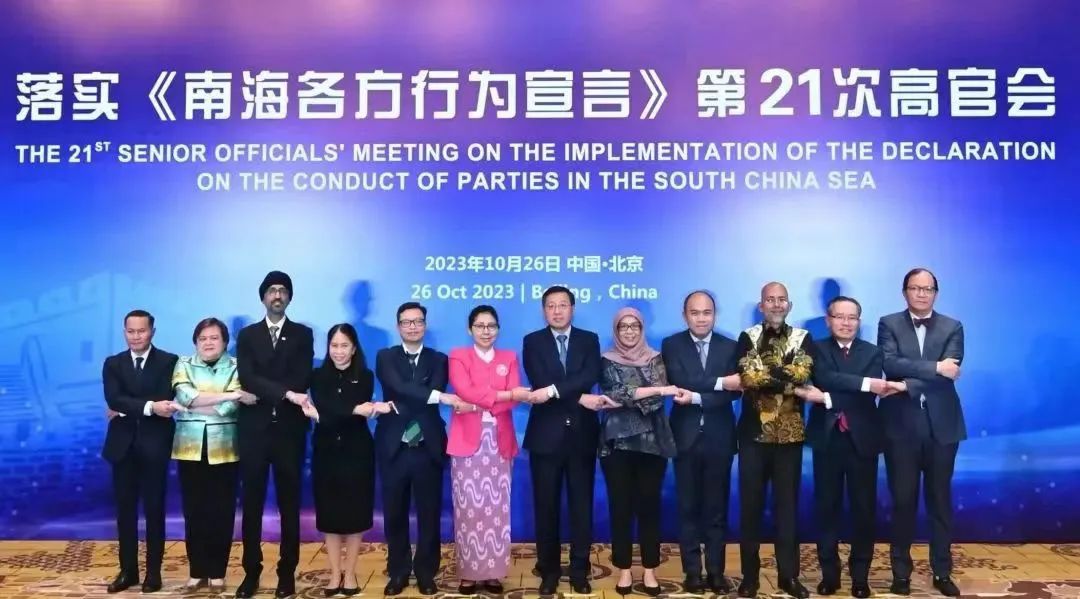From October 23-26, 2023, China and ASEAN countries held the 21st Senior Officials’ Meeting and 41st Joint Working Group Meeting on the Implementation of the Declaration on the Conduct of Parties in the South China Sea (DOC) in Beijing. All parties announced that the third reading of the Code of Conduct in the South China Sea (COC) would be officially launched, and that they would implement the guidelines for accelerating the conclusion of the COC and strive for the early conclusion of the COC. This shows that China and ASEAN countries have taken another step forward in promoting cooperation under the framework of the DOC.

This year, with the encouragement and support of extra-regional countries, some claimant countries have taken frequent unilateral and provocative actions, which have aggravated the volatility of the situation in the South China Sea. In this circumstance, China and ASEAN countries urgently need to consolidate and enhance political mutual trust under the framework of the DOC, continue to promote practical maritime cooperation in the South China Sea, contribute to the construction of regional maritime governance, and jointly safeguard peace and stability in the region.
DOC for 21 Years and the Maritime Cooperation with China and ASEAN Countries
The DOC is the first important political document on the South China Sea signed by China and ASEAN countries in 2002, which has consolidated the common will of all parties to maintain stability in the South China Sea and the consensus on building regional rules. Over the past two decades, the clear purposes and principles of the DOC and the practical maritime cooperation arrangements advocated by it have been observed and implemented by China and ASEAN countries, and many results have been achieved, which have played an important leading and promoting role in stabilizing the situation in the South China Sea.
First, China and ASEAN countries have set up multi-level consultation platforms and channels on maritime issues, which have played an important institutional role in dealing with maritime disputes, managing disagreements and maintaining regional peace and stability. At the multilateral level, China and ASEAN countries have set up institutionalized platforms represented by the Senior Officials' Meeting and Joint Working Group Meeting on the Implementation of the DOC, and in 2011, the parties reached the Guidelines for the Implementation of the DOC, which clarified the ways and paths of maritime cooperation, paving the way for cooperation. Even in the midst of the outbreak of the COVID-19 pandemic the parties have continued to communicate through special video conferences to maintain the achievements and promote cooperation. In addition, institutional arrangements for two hotline platforms - the hotline platform for diplomats of China and ASEAN countries to respond to maritime emergencies and the maritime search and rescue - were formed. In 2016, the parties agreed on preventive measures for maritime risk management - agreeing to apply the Code for Unplanned Encounters at Sea (CUES) in the South China Sea. At the bilateral level, China has successively established bilateral consultation mechanisms on maritime issues with relevant claimant countries: the China-Philippines Bilateral Consultation Mechanism on the South China Sea, and China-Vietnam Consultative Working Groups on Maritime Issues. These bilateral consultation mechanisms on maritime issues have provided platforms for claimants to enhance their understanding of each other's policies on the South China Sea, manage their differences and prevent maritime accidents.
Secondly, under the framework of the DOC, China and ASEAN practical cooperation at sea has produced multidimensional results, providing a vivid example of blue cooperation between China and ASEAN countries. In the first place, functional cooperation has achieved remarkable results. Under the framework of the DOC, China and ASEAN countries have established three technical committees on safety of navigation and search and rescue, combating transnational crimes at sea, and marine scientific research and environmental protection. In 2011, China set up an RMB 3 billion China-ASEAN Maritime Cooperation Fund. At present, the fund has financed a number of projects such as the Southeast Asia Marine Environment Forecasting and Disaster Early Warning System, the Southeast Asia Endangered Marine Species and Ecosystem Protection Research, and the China-ASEAN Marine Protected Areas Eco-Management Network Construction. Furthermore, breakthrough progress has been made in maritime security cooperation. China and ASEAN countries held joint maritime exercises in the northern part of the South China Sea and in the waters near Qingdao for two consecutive years in 2018 and 2019, which not only means that the maritime security cooperation between China and ASEAN countries has stepped up to a new level, but also is a useful attempt to build a new regional security architecture. What’s more, the effectiveness of cooperation is gradually overflowing. China and ASEAN countries in practical cooperation in mutual understanding, continue to accumulate consensus, from easy to difficult, step by step, which match with the concept of blue cooperation coincides with the comprehensive strategic partnership between China and ASEAN, the construction of a community of maritime destiny and the development of the "Belt and Road" Blue Cooperation Initiative, and has gradually become an important kernel of cooperation between China and ASEAN.
Thirdly, China has continued to promote the consultation process on the COC and has made continuous progress in establishing rules and regulations for the regional order in the South China Sea, laying a regulatory foundation for China and ASEAN countries to jointly explore regional ocean governance in the South China Sea. Since China and ASEAN countries launched the consultation of COC in 2013, continuous progress has been made. From 2017, when the parties reached an agreement on the framework of the Guidelines, to 2018, when a single consultation text on the Guidelines was formed and a consultation framework with three rounds of readings was established, to 2019, when the first reading of the COC was completed ahead of schedule. Although the sudden outbreak pandemic has delayed the consultation process, China and ASEAN countries have effectively continued and maintained the consultation process by holding special online meetings. Since 2023, under the active promotion of the rotating chairmanship of Indonesia, China and ASEAN countries have indicated that they will promote the consultation process of the COC. At the China-ASEAN Foreign Ministers' Meeting on July 13, Indonesia's foreign minister said that China and ASEAN had completed the second reading of the COC and adopted the Guidelines for Accelerating the Early Conclusion of an Effective and Substantive COC. The continuous progress in the consultations on the COC is not only a joint effort by China and ASEAN countries to manage crises, build mutual trust and move in the same direction, but also a useful exploration and attempt at regional maritime order and governance in the South China Sea.
Joining Hands with ASEAN Countries to Write A New Chapter on Cooperation in the South China Sea
Over the past 21 years, China and ASEAN countries have been actively exploring under the framework of the DOC, and have accumulated valuable experience in their interactions, which will serve as a guideline for China and ASEAN countries to deepen cooperation in the South China Sea in the future.
The first and foremost, adhering to the "dual-track approach", opposing the interference of extra regional countries and jointly maintaining regional peace and stability is the basic guarantee for development. The South China Sea is a complex and sensitive issue, and with major power competition and the profound evolution of the situations, some extra regional countries acting in their own interests, have continued to increase their involvement in South China Sea affairs, expand their military presence in the region as well as the extent and frequency of their actions, stirring up contradictions and disagreements among countries in this region, disrupting the regional order, and destroying the basis of mutual trust and cooperation among all parties. Over the years, the signing of the DOC and its practice have fully demonstrated that regional countries are fully willing and capable of resolving their problems. China and the ASEAN countries should continue to adhere to the principle and spirit of the "dual-track approach", limit disputes and differences to a manageable level, and lay a solid foundation for cooperation and development.
Besides, it adheres to the "East Asian model", and takes into account the comfort level of all parties and creates a conducive atmosphere for maximizing the interests of all parties. The conclusion and implementation of the DOC fully embodies the spiritual core of East Asian culture, such as China's seeking common ground while reserving differences, and the ASEAN Way of consensus and taking care of the comfort level of all parties, and has become an effective way to forge and maintain consensus. China and ASEAN countries should always adhere to the fine traditions of mutual respect, commitment and trustworthiness, abandon narrow-minded egoism, and uphold and practice the spirit and concept of openness, cooperation and win-win situation, so as to give impetus to higher-level exchanges and cooperation in the future.
In addition, China and ASEAN should persist in practical cooperation, and the gradual deepening and expansion of cooperation areas and projects will be a key source of mutual trust between the parties. Under the framework of implementing the DOC, China and ASEAN countries have made remarkable achievements in maritime practical cooperation. In the next step, the two sides should take advantage of a series of development initiatives and opportunities such as the China-ASEAN FTA upgrade 3.0 negotiations, the Blue Partnership Framework, the construction of the Community with a shared future Destiny, and the "the Belt and Road" Initiative, to consolidate and build up a consensus on cooperation among all parties.
Last but not least, insisting on promoting the early conclusion of the COC and accelerating the construction of the South China Sea regional regulation and governance model is an indispensable way to promote long-term peace and stability in the South China Sea. The third reading of the COC means that the consultations have officially entered the "deep-water zone", and the contradictions and differences among the parties will become more and more obvious. On the one hand, China and ASEAN countries should remain vigilant against the intervention of extra-regional countries, so as to prevent interfering with the process of the COC. On the other hand, they should always exercise self-restraint, and limit certain claimant countries' attempts to change the status quo, solidify and expand their illegal encroachment by taking advantage of the window of the COC consultation.
The year 2023 will mark the 10th anniversary of building a closer China-ASEAN community with a shared future and the Belt and Road Initiative, as well as the 20th anniversary of China's accession to the Treaty of Amity and Cooperation in Southeast Asia (TAC). China and ASEAN countries should continue to deepen their cooperation, join hands in more areas, jointly promote regional peace and stability and mutually beneficial and win-win development, and set an example for global ocean cooperation and governance.

